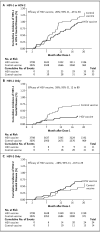Efficacy results of a trial of a herpes simplex vaccine
- PMID: 22216840
- PMCID: PMC3287348
- DOI: 10.1056/NEJMoa1103151
Efficacy results of a trial of a herpes simplex vaccine
Abstract
Background: Two previous studies of a herpes simplex virus type 2 (HSV-2) subunit vaccine containing glycoprotein D in HSV-discordant couples revealed 73% and 74% efficacy against genital disease in women who were negative for both HSV type 1 (HSV-1) and HSV-2 antibodies. Efficacy was not observed in men or HSV-1 seropositive women.
Methods: We conducted a randomized, double-blind efficacy field trial involving 8323 women 18 to 30 years of age who were negative for antibodies to HSV-1 and HSV-2. At months 0, 1, and 6, some subjects received the investigational vaccine, consisting of 20 μg of glycoprotein D from HSV-2 with alum and 3-O-deacylated monophosphoryl lipid A as an adjuvant; control subjects received the hepatitis A vaccine, at a dose of 720 enzyme-linked immunosorbent assay (ELISA) units. The primary end point was occurrence of genital herpes disease due to either HSV-1 or HSV-2 from month 2 (1 month after dose 2) through month 20.
Results: The HSV vaccine was associated with an increased risk of local reactions as compared with the control vaccine, and it elicited ELISA and neutralizing antibodies to HSV-2. Overall, the vaccine was not efficacious; vaccine efficacy was 20% (95% confidence interval [CI], -29 to 50) against genital herpes disease. However, efficacy against HSV-1 genital disease was 58% (95% CI, 12 to 80). Vaccine efficacy against HSV-1 infection (with or without disease) was 35% (95% CI, 13 to 52), but efficacy against HSV-2 infection was not observed (-8%; 95% CI, -59 to 26).
Conclusions: In a study population that was representative of the general population of HSV-1- and HSV-2-seronegative women, the investigational vaccine was effective in preventing HSV-1 genital disease and infection but not in preventing HSV-2 disease or infection. (Funded by the National Institute of Allergy and Infectious Diseases and GlaxoSmithKline; ClinicalTrials.gov number, NCT00057330.).
Figures


References
-
- Xu F, Sternberg MR, Kottiri BJ, et al. Trends in herpes simplex virus type 1 and type 2 seroprevalence in the United States. JAMA. 2006;296:964–73. - PubMed
-
- Langenberg A, Benedetti J, Jenkins J, Ashley R, Winter C, Corey L. Development of clinically recognizable genital lesions among women previously identified as having “asymptomatic” herpes simplex virus type 2 infection. Ann Intern Med. 1989;110:822–7. - PubMed
-
- Koutsky LA, Stevens CE, Holmes KK, et al. Underdiagnosis of genital herpes by current clinical and viral-isolation procedures. N Engl J Med. 1992;326:1533–9. - PubMed
-
- Stanberry LR, Spruance SL, Cunningham AL, et al. Glycoprotein-D-adjuvant vaccine to prevent genital herpes. N Engl J Med. 2002;347:1652–61. - PubMed
-
- Wald A, Zeh J, Selke S, et al. Reactivation of genital herpes simplex virus type 2 infection in asymptomatic seropositive persons. N Engl J Med. 2000;342:844–50. - PubMed
Publication types
MeSH terms
Substances
Associated data
Grants and funding
LinkOut - more resources
Full Text Sources
Other Literature Sources
Medical
